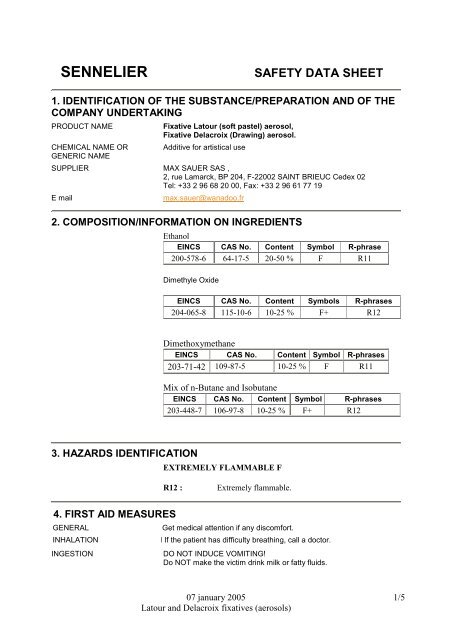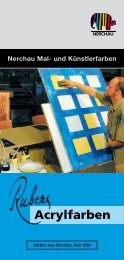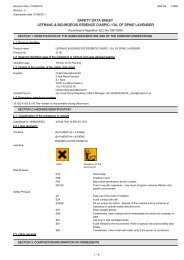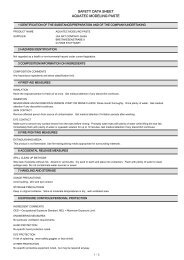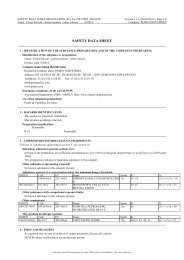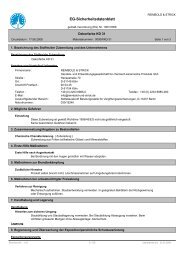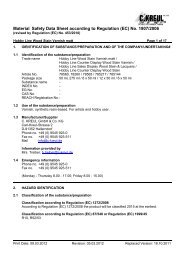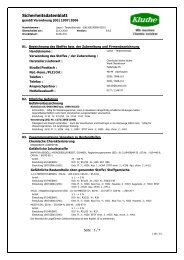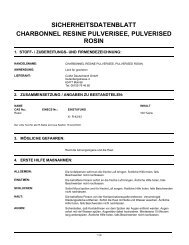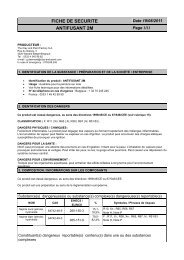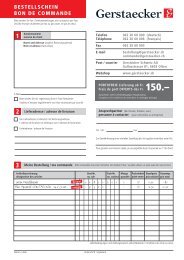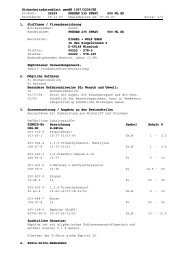sennelier safety data sheet - Aart de Vos
sennelier safety data sheet - Aart de Vos
sennelier safety data sheet - Aart de Vos
You also want an ePaper? Increase the reach of your titles
YUMPU automatically turns print PDFs into web optimized ePapers that Google loves.
SENNELIER<br />
SAFETY DATA SHEET<br />
1. IDENTIFICATION OF THE SUBSTANCE/PREPARATION AND OF THE<br />
COMPANY UNDERTAKING<br />
PRODUCT NAME<br />
CHEMICAL NAME OR<br />
GENERIC NAME<br />
Fixative Latour (soft pastel) aerosol,<br />
Fixative Delacroix (Drawing) aerosol.<br />
Additive for artistical use<br />
SUPPLIER MAX SAUER SAS ,<br />
2, rue Lamarck, BP 204, F-22002 SAINT BRIEUC Ce<strong>de</strong>x 02<br />
Tel: +33 2 96 68 20 00, Fax: +33 2 96 61 77 19<br />
E mail<br />
max.sauer@wanadoo.fr<br />
2. COMPOSITION/INFORMATION ON INGREDIENTS<br />
Ethanol<br />
EINCS CAS No. Content Symbol R-phrase<br />
200-578-6 64-17-5 20-50 % F R11<br />
Dimethyle Oxi<strong>de</strong><br />
EINCS CAS No. Content Symbols R-phrases<br />
204-065-8 115-10-6 10-25 % F+ R12<br />
Dimethoxymethane<br />
EINCS CAS No. Content Symbol R-phrases<br />
203-71-42 109-87-5 10-25 % F R11<br />
Mix of n-Butane and Isobutane<br />
EINCS CAS No. Content Symbol R-phrases<br />
203-448-7 106-97-8 10-25 % F+ R12<br />
3. HAZARDS IDENTIFICATION<br />
EXTREMELY FLAMMABLE F<br />
R12 :<br />
Extremely flammable.<br />
4. FIRST AID MEASURES<br />
GENERAL<br />
INHALATION<br />
INGESTION<br />
Get medical attention if any discomfort.<br />
I If the patient has difficulty breathing, call a doctor.<br />
DO NOT INDUCE VOMITING!<br />
Do NOT make the victim drink milk or fatty fluids.<br />
07 january 2005 1/5<br />
Latour and Delacroix fixatives (aerosols)
SKIN<br />
EYES<br />
Remove contaminated clothing.<br />
Get medical attention promptly if symptoms occur after washing.<br />
Continue to rinse for at least 15 minutes and get medical attention.<br />
5. FIRE FIGHTING MEASURES<br />
EXTINGUISHING MEDIA<br />
SPECIAL FIRE FIGHTING<br />
PROCEDURES<br />
SPECIFIC HAZARDS<br />
HAZARDOUS COMBUSTION<br />
PRODUCTS<br />
PROTECTIVE MEASURES IN<br />
FIRE<br />
6. ACCIDENTAL RELEASE MEASURES<br />
PERSONAL PROTECTION<br />
ENVIRONMENTAL<br />
PROTECTION<br />
SPILL CLEANUP METHODS<br />
7. HANDLING AND STORAGE<br />
USAGE PRECAUTIONS<br />
STORAGE PRECAUTIONS<br />
RECOMMENDED : Water spray, fog or mist. Pow<strong>de</strong>r, foam or CO2.<br />
NOT SUITABLE : Water jet.<br />
Treat as hydrocarbon fire.<br />
In case of fire and/or explosion do not breathe fumes.<br />
Forms explosive mixtures with air.<br />
Toxic gases/vapours/fumes: Carbon monoxi<strong>de</strong> (CO), Carbon dioxi<strong>de</strong><br />
(CO2), Nitrous gases (NOx). ... .<br />
Wear individual breathing apparatus.<br />
Avoid inhaling vapours.<br />
Discharge in sewers prohibited.<br />
Absorb in vermiculite, dry sand or earth and place into containers.<br />
Wear necessary protective equipment.<br />
Extinguish all ignition sources. Avoid sparks, flames, heat and<br />
smoking. Ventilate.<br />
Avoid contact with skin or inhalation of spillage, dust or vapour.<br />
Provi<strong>de</strong> ventilation and confine spill. Do not allow runoff to sewer.<br />
Do not contaminate water sources or sewer.<br />
Keep away from heat, sparks and open flame.<br />
Ventilate well, avoid breathing vapours. In case of insufficient<br />
ventilation, wear suitable respiratory equipment.<br />
Avoid spilling, skin and eye contact.<br />
Keep apart from all ignition equipment. No smoking.<br />
Pressurized container. Protect from sunlight. Do not expose to<br />
temperatures exceedong 50°C.<br />
Keep out of the reach of children.<br />
8. EXPOSURE CONTROLS/PERSONAL PROTECTION<br />
PROCESS CONDITIONS<br />
VENTILATION<br />
RESPIRATORS<br />
PROTECTIVE GLOVES<br />
EYE PROTECTION<br />
Use engineering controls to reduce air contamination to permissible<br />
exposure level.<br />
Provi<strong>de</strong> eyewash station.<br />
Provi<strong>de</strong> a<strong>de</strong>quate general and local exhaust ventilation.<br />
Do NOT breathe vapours.<br />
If ventilation is insufficient, suitable respiratory protection must be<br />
provi<strong>de</strong>d.<br />
Use protective gloves.<br />
Wear approved <strong>safety</strong> goggles.<br />
07 january 2005 2/5<br />
Latour and Delacroix fixatives (aerosols)
OTHER PROTECTION Wear appropriate clothing to prevent any possibility of liquid contact<br />
and repeated or prolonged vapour contact.<br />
HYGIENIC WORK PRACTICES DO NOT SMOKE IN WORK AREA!<br />
No eating or drinking while working with this material.<br />
Wash at the end of each work shift and before eating, smoking and<br />
using the toilet.<br />
9. PHYSICAL AND CHEMICAL PROPERTIES<br />
APPEARANCE<br />
Liquid.<br />
COLOUR<br />
Colourless.<br />
ODOUR<br />
Organic solvents.<br />
PHYSICAL DATA COMMENTS Take precautionary measures against electrostatic discharges.<br />
DENSITY/SPECIFIC GRAVITY nd<br />
(g/ml)<br />
FLASH POINT (°C) < 0 °C<br />
Method :Sh CC (Setaflash closed cup).<br />
BOILING POINT < 35 °C<br />
10. STABILITY AND REACTIVITY<br />
STABILITY<br />
CONDITIONS TO AVOID<br />
HAZARDOUS DECOMP.<br />
PRODUCTS<br />
11. TOXICOLOGICAL INFORMATION<br />
INHALATION<br />
INGESTION<br />
SKIN<br />
EYES<br />
12. ECOLOGICAL INFORMATION<br />
Stable un<strong>de</strong>r normal storage condition.<br />
Avoid heat.<br />
Avoid contact with acids and oxidising substances.<br />
Fire creates:<br />
Toxic gases/vapours/fumes of: Carbon monoxi<strong>de</strong> (CO), Carbon<br />
dioxi<strong>de</strong> (CO2), Nitrous gases (NOx). ...<br />
Solvent vapours are hazardous and may cause nausea, sickness and<br />
headaches.<br />
Drowsiness, dizziness, disorientation, vertigo.<br />
Liquid irritates mucous membranes and may cause abdominal pain if<br />
swallowed.<br />
Prolonged or repeated contact leads to drying of skin.<br />
May cause severe irritation to eyes.<br />
ECOLOGICAL INFORMATION Do not discharge into drains or the environment ; dispose to an<br />
authorised waste collection point.<br />
13. DISPOSAL CONSIDERATIONS<br />
DISPOSAL METHODS<br />
AEROSOL: do not pierce or burn, even after use.<br />
Contact specialist disposal companies.<br />
Do not allow runoff to sewer, waterway or ground.<br />
Store waste impregnated with solvents in closed sealed containers<br />
07 january 2005 3/5<br />
Latour and Delacroix fixatives (aerosols)
14. TRANSPORT INFORMATION<br />
UN NO. ROAD 1950<br />
ADR CLASS Class 2.<br />
HAZARD NO. (ADR)<br />
5f<br />
HAZCHEM CODE<br />
PROPER SHIPPING NAME AEROSOLS, n.o.s.<br />
(NATIONAL)<br />
SEA TRANSPORT:<br />
UN NO. SEA 1950<br />
CLASS 2<br />
EMS NO.<br />
MFAG TABLE NO.<br />
MARINE POLLUTANT<br />
AIR TRANSPORT:<br />
UN NO., AIR 1950<br />
IATA/ICAO PACKING GROUP<br />
PACKING INSTRUCTIONS 203<br />
15. REGULATORY INFORMATION<br />
SYMBOLS<br />
EXTREMELY FLAMMABLE F+,<br />
RISK PHRASES R12 : Extremely flammable.<br />
SAFETY PHRASES S2: Keep out of the reach of children.<br />
S16 : Keep away from sources of ignition- No smoking.Use<br />
and stow apart from all flames, ignition, sparks, heat or electrical<br />
equipment in function.<br />
Pressurized container. Protect from sunlight. Do not expose to<br />
temperatures exceeding 50°C.<br />
Do not pierce or burn, even after use.<br />
Do not spray on a naked flame or any incan<strong>de</strong>scent material.<br />
S51: Use only in well-ventilated areas.<br />
S23: Do not breathe spray.<br />
S46: If swallowed, seek medical advice immediately and<br />
show this container or label.<br />
Proceed in short pressures, not too exten<strong>de</strong>d.<br />
Do not use in a different way than explained opn the package.<br />
Commission Directive 2001/59/EC of 6 August 2001 adapting to<br />
technical progress for the 28th time Council Directive 67/548/EEC on<br />
the approximation of the laws, regulations and administrative<br />
provisions relating to the classification, packaging and labelling of<br />
dangerous substances (Official Journal L 225 - 21/08/2001).<br />
Dangerous preparations : Directive 99/45 amen<strong>de</strong>d byDirective<br />
2001/60/EC - OJEC L226 - 22/08/2001.<br />
Directive 91/155/EEC amen<strong>de</strong>d by Directive 93/112/EEC and<br />
Directive 2001/58/EC : Safety <strong>data</strong> <strong>sheet</strong>s.<br />
07 january 2005 4/5<br />
Latour and Delacroix fixatives (aerosols)
16. OTHER INFORMATION<br />
USER NOTES:<br />
This information ONLY applies to this product which conforms to the<br />
specification of Max Sauer SAS.<br />
In case of formulations or mixtures, the user must ensure that new<br />
hazards are not apparent in line with the above.<br />
The information contained herein is based on our knowledge of the<br />
product, at the date of publishing and it is given in good faith.<br />
Please note the possible risks involved if this product is used for<br />
applications other than those for which it is intented.<br />
This <strong>sheet</strong> shall only be used and reproduced for Health & Safety<br />
purposes.<br />
The references to legislative & regulatory information and co<strong>de</strong>s of<br />
practice are not exhaustive. Other applicable regulations may be<br />
consi<strong>de</strong>red.<br />
It is the responsibility of the user to refer to existing legislation<br />
concerning the use, the storage and the safe handling of the product.<br />
It is also the responsibility of the user to communicate ALL information<br />
related to the protection of Health, Safety & the Environment<br />
contained within this Material Safety Data Sheet to those persons<br />
involved in the handling of this product.<br />
07 january 2005 5/5<br />
Latour and Delacroix fixatives (aerosols)


